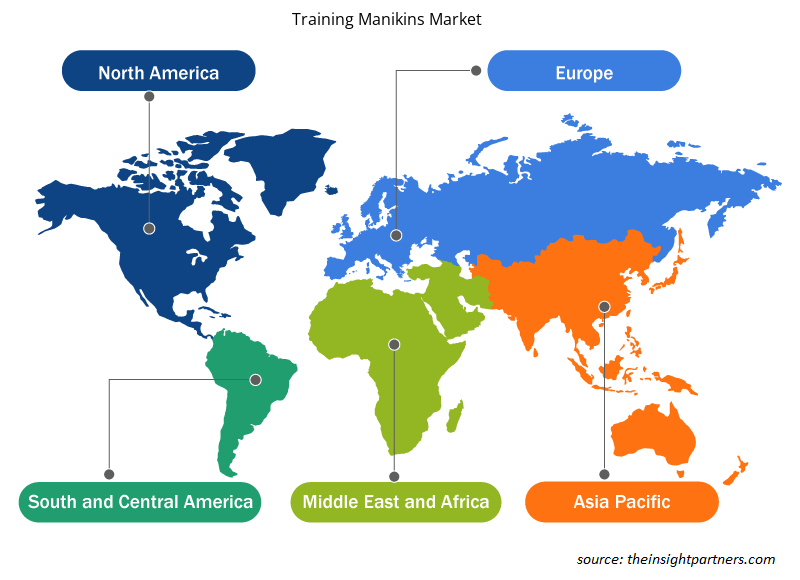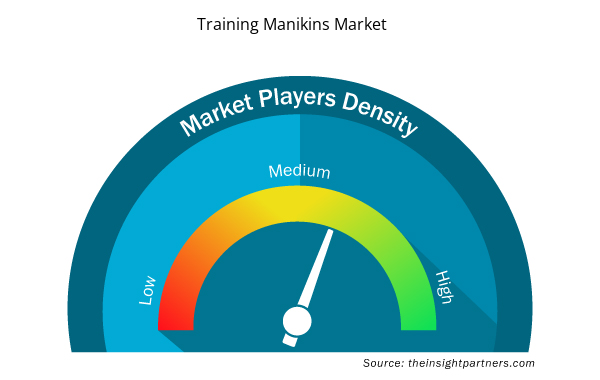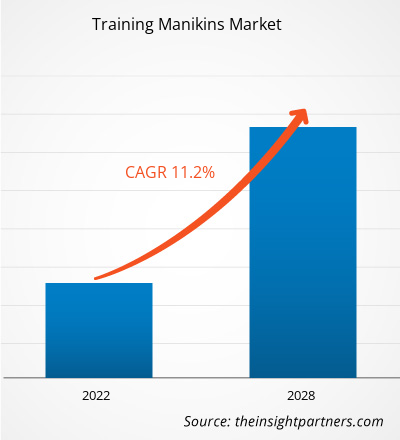训练人体模型市场规模预计将从 2021 年的 12.3561 亿美元增至 2028 年的 26.0389 亿美元。预计 2021-2028 年期间全球训练人体模型市场规模的复合年增长率为 11.2%。
训练人体模型是成人、儿童或婴儿的复制品,具有模拟气道、器官或器官系统。它们用于教授和训练心肺复苏术、高级气道管理和外科手术。训练人体模型可以是全身的,也可以只有训练或演示所需的相关身体部位。自 1950 年代以来,训练人体模型一直用于演示和训练执行心肺复苏术。机器人技术和其他技术的使用进一步改善了人体模型的响应反馈,这有助于获得更好的学习体验。
训练 人体模型市场的增长归因于训练人体模型技术的进步和全球院外心脏骤停发生率的上升。然而,与训练人体模型的真实性相关的问题可能会在预测期内阻碍训练人体模型市场的增长。
定制此报告以满足您的需求
您可以免费定制任何报告,包括本报告的部分内容、国家级分析、Excel 数据包,以及为初创企业和大学提供优惠和折扣
- 获取此报告的关键市场趋势。这个免费样品将包括数据分析,从市场趋势到估计和预测。
市场洞察
院外心脏骤停和心肺复苏 (CPR) 培训和意识项目的普及率不断提高,推动了训练人体模型市场的发展
2020 年发表的一项名为《接受心肺复苏的成人院外心脏骤停患者的全球存活率:系统评价和荟萃分析》的研究评估了某一地区接受旁观者或紧急医疗服务实施心肺复苏的院外心脏骤停患者的存活率。研究报告称,过去几年院外心脏骤停患者的存活率显著上升,而接受心肺复苏并居住在西方国家的患者的存活率更高。训练人体模型最常见的用途之一是进行心肺复苏训练。心血管疾病 (CVD) 是全球发病和死亡的主要原因。世界卫生组织 (WHO) 估计,每年全球有 1790 万人死于心血管疾病,占报告死亡人数的 32%。五分之四的心血管疾病相关死亡是由于心脏病发作和中风。西方国家对心肺复苏术 (CPR) 的认识很高。2019 年,欧洲和美国发生了约 700,000 例院外心脏骤停 (OHCA),其中很大一部分发生在家中和公共场所。此外,例如,英国的高级冠状动脉治疗 (ACT) 基金会为不列颠哥伦比亚省紧急医疗服务 (BCEHS) 的中学生推出了一项培训计划。护理人员志愿者培训教师,以教育 BCEHS 的学生。在某些大学,BCEHS 计划将培训人体模型培训作为体育课程的一部分。英国心脏基金会的“救生员之国——呼叫、推挤、救援”是另一个简化培训计划的例子,该计划侧重于仅按压的 CPR 和 AED。英国心脏基金会还带头号召医疗专业人士支持英国的公共教育。总体而言,随着政府和地方机构组织的宣传和培训计划,训练人体模型市场正在稳步增长。
基于类型的洞察
根据类型,全球训练人体模型市场细分为 CPR 训练人体模型、婴儿人体模型等。CPR 训练人体模型部分很可能在 2021 年占据训练人体模型市场的最大份额。CPR 训练人体模型部分预计将在 2021 年至 2028 年期间实现最快的复合年增长率,即 11.7%,因为院外突发心脏骤停 (OHCA) 的增加以及无效的心肺复苏 (CPR) 是全球第三大死亡原因。
培训人体模型市场区域洞察
Insight Partners 的分析师已详细解释了预测期内影响训练人体模型市场的区域趋势和因素。本节还讨论了北美、欧洲、亚太地区、中东和非洲以及南美和中美洲的训练人体模型市场细分和地理位置。

- 获取训练人体模型市场的区域特定数据
培训人体模型市场报告范围
| 报告属性 | 细节 |
|---|---|
| 2021 年市场规模 | 12.4亿美元 |
| 2028 年市场规模 | 26亿美元 |
| 全球复合年增长率(2021 - 2028) | 11.2% |
| 史料 | 2019-2020 |
| 预测期 | 2022-2028 |
| 涵盖的领域 | 按类型
|
| 覆盖地区和国家 | 北美
|
| 市场领导者和主要公司简介 |
|
训练人体模型市场参与者密度:了解其对业务动态的影响
训练人体模型市场正在快速增长,这得益于终端用户需求的不断增长,而这些需求又源于消费者偏好的不断变化、技术进步以及对产品优势的认识不断提高等因素。随着需求的增加,企业正在扩大其产品范围,进行创新以满足消费者的需求,并利用新兴趋势,从而进一步推动市场增长。
市场参与者密度是指在特定市场或行业内运营的企业或公司的分布情况。它表明在给定市场空间中,相对于其规模或总市场价值,有多少竞争对手(市场参与者)存在。
在训练人体模型市场运营的主要公司有:
- Ambu 公司
- Gaumard 科学公司
- 莱德尔医疗公司
- 救生资源有限公司
- 医学教育技术公司
免责声明:上面列出的公司没有按照任何特定顺序排列。

- 获取训练人体模型市场顶级关键参与者概览
基于应用的洞察
根据应用,全球训练人体模型市场分为医院、诊所和其他。医院部门很可能在 2021 年占据最大的市场份额。此外,由于世界各地医院对训练人体模型的使用增加,预计该部门的需求也将以最快的复合年增长率增长,即 2021 年至 2028 年期间为 11.8%。
产品发布和审批是公司常用的策略,以扩大其全球足迹和产品组合,从而占据训练人体模型市场份额。此外,训练人体模型市场参与者专注于合作战略,以扩大其客户群,这反过来又使他们能够在全球范围内保持其品牌名称。随着训练人体模型市场参与者开发新的创新产品,训练人体模型市场份额预计将蓬勃发展。
公司简介
- 安布公司
- Gaumard 科学公司,
- 莱德尔医疗公司
- 救生资源有限公司
- 医学教育技术公司
- Simulaids 公司
- 亚里士多德公司
- 美国心肺复苏术
- 纳斯科
- TruCorp。
- 历史分析(2 年)、基准年、预测(7 年)及复合年增长率
- PEST 和 SWOT 分析
- 市场规模价值/数量 - 全球、区域、国家
- 行业和竞争格局
- Excel 数据集



Report Coverage
Revenue forecast, Company Analysis, Industry landscape, Growth factors, and Trends

Segment Covered
This text is related
to segments covered.

Regional Scope
North America, Europe, Asia Pacific, Middle East & Africa, South & Central America

Country Scope
This text is related
to country scope.
常见问题
The factors that are driving the growth of the market are the advancements in the technologies used in the development of manikins and the increasing prevalence of out-of-hospital cardiac arrests and cardiopulmonary resuscitation training and awareness programs. Moreover, the training for COVID-19 pandemic and the use of remote training have provided growth opportunities to the market.
The training manikins market majorly consists of the players such as Ambu, Inc., Gaumard Scientific Company, Inc., Laedral Medical A/S, Simulaids, Inc., American CPR, Nasco Healthcare, TruCorp., and CAE Inc., among others.
Training manikins are a replica of an adult, child, or infant human with simulated airways, organs, or organ systems. These are used for teaching and training of CPR, advanced airway management, and surgical procedures. Training manikins can be full-body or have only the relevant body parts necessary for the training or demonstration. As technology has developed, the training manikins have become more sophisticated with airways, organs, and organ systems that resemble the human anatomical systems that have been made to provide a high-fidelity experience to the user. The use of robotics and other technologies has further improved the responsive feedback of the manikins which have aided in better learning experiences.
Trends and growth analysis reports related to Life Sciences : READ MORE..
The List of Companies - Training Manikins market
- Ambu, Inc.
- Gaumard Scientific Company, Inc
- Laedral Medical A/S
- LifeSaving Resources, Inc.
- Medical Education Technologies, Inc.
- Simulaids, Inc.
- The Aristotle Corp.
- American CPR
- Nasco
- TruCorp.
The Insight Partners performs research in 4 major stages: Data Collection & Secondary Research, Primary Research, Data Analysis and Data Triangulation & Final Review.
- Data Collection and Secondary Research:
As a market research and consulting firm operating from a decade, we have published and advised several client across the globe. First step for any study will start with an assessment of currently available data and insights from existing reports. Further, historical and current market information is collected from Investor Presentations, Annual Reports, SEC Filings, etc., and other information related to company’s performance and market positioning are gathered from Paid Databases (Factiva, Hoovers, and Reuters) and various other publications available in public domain.
Several associations trade associates, technical forums, institutes, societies and organization are accessed to gain technical as well as market related insights through their publications such as research papers, blogs and press releases related to the studies are referred to get cues about the market. Further, white papers, journals, magazines, and other news articles published in last 3 years are scrutinized and analyzed to understand the current market trends.
- Primary Research:
The primarily interview analysis comprise of data obtained from industry participants interview and answers to survey questions gathered by in-house primary team.
For primary research, interviews are conducted with industry experts/CEOs/Marketing Managers/VPs/Subject Matter Experts from both demand and supply side to get a 360-degree view of the market. The primary team conducts several interviews based on the complexity of the markets to understand the various market trends and dynamics which makes research more credible and precise.
A typical research interview fulfils the following functions:
- Provides first-hand information on the market size, market trends, growth trends, competitive landscape, and outlook
- Validates and strengthens in-house secondary research findings
- Develops the analysis team’s expertise and market understanding
Primary research involves email interactions and telephone interviews for each market, category, segment, and sub-segment across geographies. The participants who typically take part in such a process include, but are not limited to:
- Industry participants: VPs, business development managers, market intelligence managers and national sales managers
- Outside experts: Valuation experts, research analysts and key opinion leaders specializing in the electronics and semiconductor industry.
Below is the breakup of our primary respondents by company, designation, and region:

Once we receive the confirmation from primary research sources or primary respondents, we finalize the base year market estimation and forecast the data as per the macroeconomic and microeconomic factors assessed during data collection.
- Data Analysis:
Once data is validated through both secondary as well as primary respondents, we finalize the market estimations by hypothesis formulation and factor analysis at regional and country level.
- Macro-Economic Factor Analysis:
We analyse macroeconomic indicators such the gross domestic product (GDP), increase in the demand for goods and services across industries, technological advancement, regional economic growth, governmental policies, the influence of COVID-19, PEST analysis, and other aspects. This analysis aids in setting benchmarks for various nations/regions and approximating market splits. Additionally, the general trend of the aforementioned components aid in determining the market's development possibilities.
- Country Level Data:
Various factors that are especially aligned to the country are taken into account to determine the market size for a certain area and country, including the presence of vendors, such as headquarters and offices, the country's GDP, demand patterns, and industry growth. To comprehend the market dynamics for the nation, a number of growth variables, inhibitors, application areas, and current market trends are researched. The aforementioned elements aid in determining the country's overall market's growth potential.
- Company Profile:
The “Table of Contents” is formulated by listing and analyzing more than 25 - 30 companies operating in the market ecosystem across geographies. However, we profile only 10 companies as a standard practice in our syndicate reports. These 10 companies comprise leading, emerging, and regional players. Nonetheless, our analysis is not restricted to the 10 listed companies, we also analyze other companies present in the market to develop a holistic view and understand the prevailing trends. The “Company Profiles” section in the report covers key facts, business description, products & services, financial information, SWOT analysis, and key developments. The financial information presented is extracted from the annual reports and official documents of the publicly listed companies. Upon collecting the information for the sections of respective companies, we verify them via various primary sources and then compile the data in respective company profiles. The company level information helps us in deriving the base number as well as in forecasting the market size.
- Developing Base Number:
Aggregation of sales statistics (2020-2022) and macro-economic factor, and other secondary and primary research insights are utilized to arrive at base number and related market shares for 2022. The data gaps are identified in this step and relevant market data is analyzed, collected from paid primary interviews or databases. On finalizing the base year market size, forecasts are developed on the basis of macro-economic, industry and market growth factors and company level analysis.
- Data Triangulation and Final Review:
The market findings and base year market size calculations are validated from supply as well as demand side. Demand side validations are based on macro-economic factor analysis and benchmarks for respective regions and countries. In case of supply side validations, revenues of major companies are estimated (in case not available) based on industry benchmark, approximate number of employees, product portfolio, and primary interviews revenues are gathered. Further revenue from target product/service segment is assessed to avoid overshooting of market statistics. In case of heavy deviations between supply and demand side values, all thes steps are repeated to achieve synchronization.
We follow an iterative model, wherein we share our research findings with Subject Matter Experts (SME’s) and Key Opinion Leaders (KOLs) until consensus view of the market is not formulated – this model negates any drastic deviation in the opinions of experts. Only validated and universally acceptable research findings are quoted in our reports.
We have important check points that we use to validate our research findings – which we call – data triangulation, where we validate the information, we generate from secondary sources with primary interviews and then we re-validate with our internal data bases and Subject matter experts. This comprehensive model enables us to deliver high quality, reliable data in shortest possible time.


 获取此报告的免费样本
获取此报告的免费样本